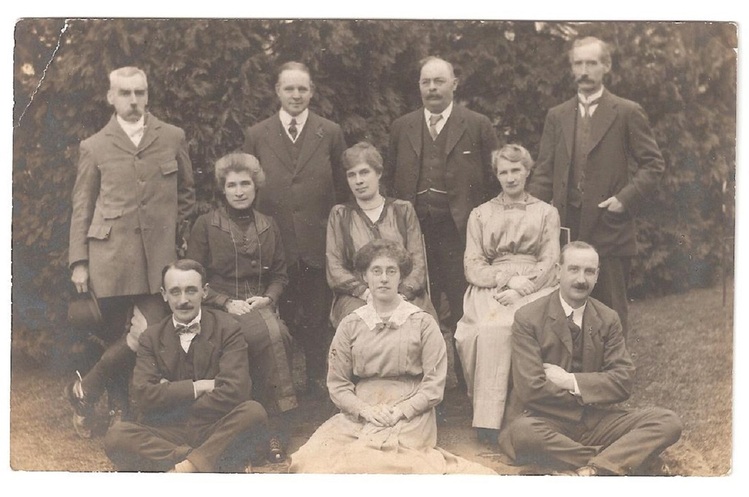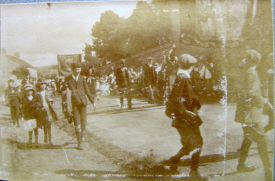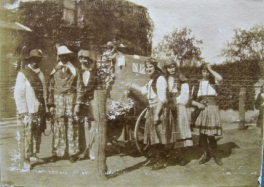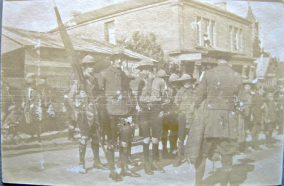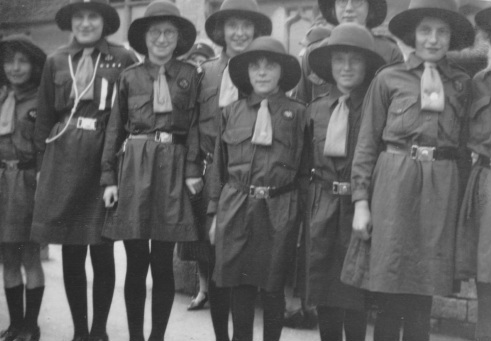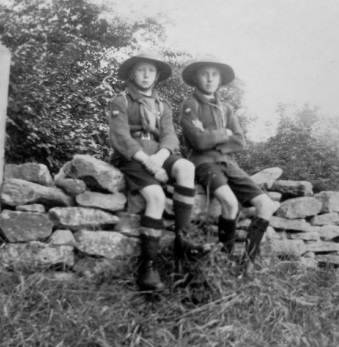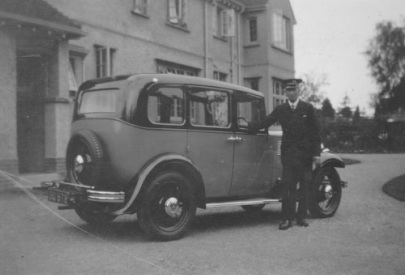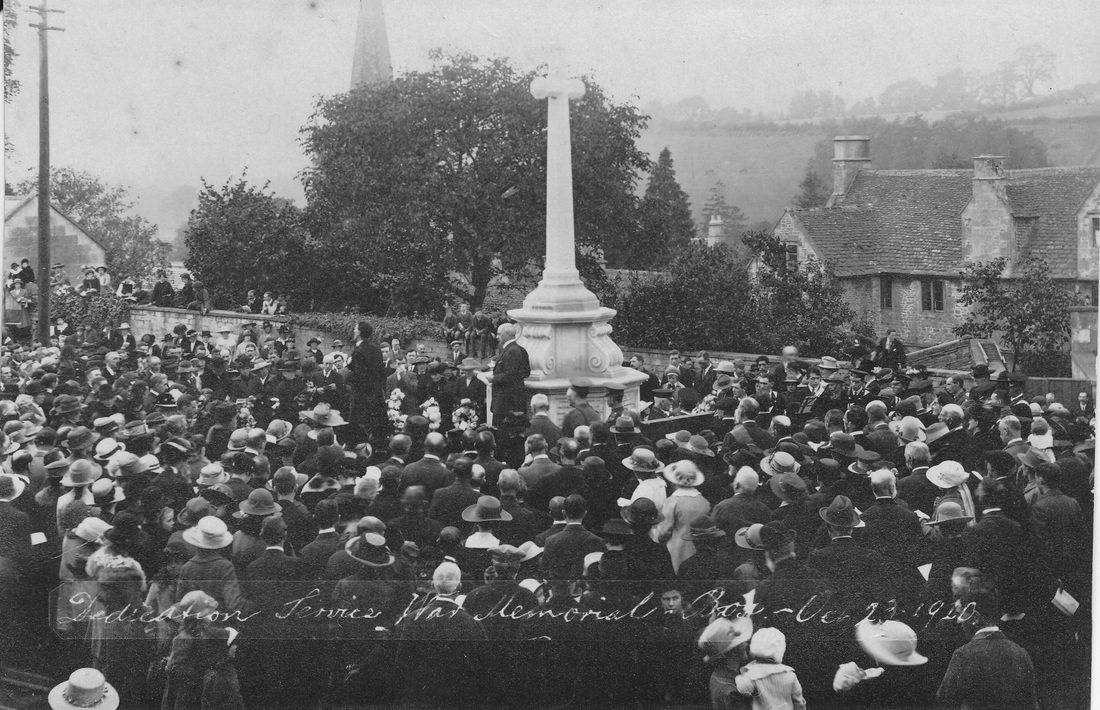Life in Box After the Great War Alan Payne, September 2014
The Box Worthies
Jane Browning sent us this fabulous picture and wrote:
This photo is usually called, somewhat tongue-in-cheek, the Box Worthies. The photo was taken in 1918 of the Box Whist Drive Committee; rather a large committee ! The people are, from the left: back row, Dr Martin, Charlie W Oatley, Edwin Pinchin, Tom Lambert; middle row, Mrs Goulstone, Mrs Shewring, Mrs Marion Daniell; front row, James White Browning, Miss Ettie Fudge, Ben Vezey. Perhaps you could put it on the site with this information and ask for any further information/stories about any of them.
Jane Browning sent us this fabulous picture and wrote:
This photo is usually called, somewhat tongue-in-cheek, the Box Worthies. The photo was taken in 1918 of the Box Whist Drive Committee; rather a large committee ! The people are, from the left: back row, Dr Martin, Charlie W Oatley, Edwin Pinchin, Tom Lambert; middle row, Mrs Goulstone, Mrs Shewring, Mrs Marion Daniell; front row, James White Browning, Miss Ettie Fudge, Ben Vezey. Perhaps you could put it on the site with this information and ask for any further information/stories about any of them.
The photo shows positives about life after the Great War, such as the acceptance of women’s right to independence from male chaperones. But it also shows the impact of the conflict; the death of so many young people leaving an older population, brought up on Victorian values and concepts, to try to deal with immense post-war problems.
Who were these people? And what problems did they face?
Who were these people? And what problems did they face?
The People
Dr Martin (1858 - 1943): long serving doctor and Chair of Parish Council for 28 years who lived at The Paddocks
Charlie W Oatley JP (1877 - 1950): furniture dealer who had a shack next to the school and a furniture store in Corsham
Edwin Skeate Pinchin (1868 - 1924): Box brewer and maltster who lived at Brewery House
Tom Lambert (1860 - 1938): stone company owner and member of first Parish Council, 1894, who lived at Kingston Villas
Mrs Mary Anne Goulstone (1868 - 1939) wife of Frederick James Goulstone of Hill House Farm
Mrs Elizabeth Mary Shewring (b 1871): widow of the owner of Northey Arms, nee Vezey
Mrs Marion Daniell (b 1865): married to Thomas Daniell who farmed at Manor Farm
James White Browning (1892 - 1960): miller, the youngest in the photo who lived at Box Mill House
Miss Ettie (Esther) Fudge (1871 - 1951): Post Mistress in Box for 36 years
Benjamin Vezey (1873 - 1930): soap & candle manufacturer from Vale View, Townsend who died in a train accident.
Dr Martin (1858 - 1943): long serving doctor and Chair of Parish Council for 28 years who lived at The Paddocks
Charlie W Oatley JP (1877 - 1950): furniture dealer who had a shack next to the school and a furniture store in Corsham
Edwin Skeate Pinchin (1868 - 1924): Box brewer and maltster who lived at Brewery House
Tom Lambert (1860 - 1938): stone company owner and member of first Parish Council, 1894, who lived at Kingston Villas
Mrs Mary Anne Goulstone (1868 - 1939) wife of Frederick James Goulstone of Hill House Farm
Mrs Elizabeth Mary Shewring (b 1871): widow of the owner of Northey Arms, nee Vezey
Mrs Marion Daniell (b 1865): married to Thomas Daniell who farmed at Manor Farm
James White Browning (1892 - 1960): miller, the youngest in the photo who lived at Box Mill House
Miss Ettie (Esther) Fudge (1871 - 1951): Post Mistress in Box for 36 years
Benjamin Vezey (1873 - 1930): soap & candle manufacturer from Vale View, Townsend who died in a train accident.
Return to Normal
The first response to the armistice of November 1918 was one of absolute relief. People in Box were war-weary and wanted to get village life back to pre-war conditions as quickly as possible. The phrases A war to end all wars and A land fit for heroes were genuine aspirations for people who longed for normal life to be restored. Of course there was the tragic work of recording the dead, assisting the maimed and caring for the mentally scarred soldiers but everywhere people rejoiced at the dawn of peace.
These wonderful photos (courtesy of Margaret Wakefield) show the joyous village celebrations to commemorate the completion of the War Memorial in the Fete of 1920.
The first response to the armistice of November 1918 was one of absolute relief. People in Box were war-weary and wanted to get village life back to pre-war conditions as quickly as possible. The phrases A war to end all wars and A land fit for heroes were genuine aspirations for people who longed for normal life to be restored. Of course there was the tragic work of recording the dead, assisting the maimed and caring for the mentally scarred soldiers but everywhere people rejoiced at the dawn of peace.
These wonderful photos (courtesy of Margaret Wakefield) show the joyous village celebrations to commemorate the completion of the War Memorial in the Fete of 1920.
The job of reconstructing life was particularly important for young boys and girls as they were to be the future of the village.
Box Cricket Club, which had ceased to function in 1916, recommenced on 12 March 1919 at the instigation of the Rev Vere Awdry, father of the Rev W Awdry.[1]
The Scouts, who had undertaken a semi-military role to assist the war effort, returned to normal with the appointment of a civilian Scoutmaster in 1919.[2] The Box troop met in premises on the Devizes Road which had formerly been classrooms moved from Ashley Manor just before the outbreak of war. For summer camp they usually set up on Kingsdown Common. In 1919 they went further afield when troop went to London to attend a jamboree attended by HRH The Prince of Wales.[3] A Girl Guide group was formed locally in March 1924 open to all girls aged 11 to 16 years.
Box Cricket Club, which had ceased to function in 1916, recommenced on 12 March 1919 at the instigation of the Rev Vere Awdry, father of the Rev W Awdry.[1]
The Scouts, who had undertaken a semi-military role to assist the war effort, returned to normal with the appointment of a civilian Scoutmaster in 1919.[2] The Box troop met in premises on the Devizes Road which had formerly been classrooms moved from Ashley Manor just before the outbreak of war. For summer camp they usually set up on Kingsdown Common. In 1919 they went further afield when troop went to London to attend a jamboree attended by HRH The Prince of Wales.[3] A Girl Guide group was formed locally in March 1924 open to all girls aged 11 to 16 years.
But all this was in vain. Edwardian society had been irreparably shattered for many reasons: the war, over-reliance on old staple industries including quarrying, long term unemployment, and population decline. It was these issues that preoccupied the Box Worthies and other village authorities in the 1920s.
Unemployment
Finding jobs for demobilised soldiers was the first concern. Some ex-servicemen put up a sign outside their house or shop Served in HM Forces 1914-18 to emphasise their commitment. For those who failed to get a job, Col JDB Erskin formed a local branch of The Comrades Legion Club, taking over the premises now called Hardy House.
The role of women had altered during the war when they had to take over work previously regarded as male jobs. The returning men caused the role of many women to revert back to domestic drudgery and endless child-minding duties. The grant of suffrage in 1918 scarcely improved the status of most Box women as it enfranchised only women over the age of 30 who met certain property ownership requirements.
The economic slump came soon after 1919 when the quarry trade went into very severe decline. The problems had started over a decade earlier when seams of stone were beginning to be difficut to extract without our modern equipment. Now it affected the whole area. At Longsplatt there was an old open-caste quarry which had expanded with a slope shaft in 1890 that enabled deeper, underground excavation of the stone seam. The quarry closed in 1920.[4] At Kingsdown, several small quarries were closed opposite The Swan pub. This was also the time when the candle and soap factory finished making candles because the industrial demand from the stone mines ended and electricity was now lighting domestic homes.The factory was later sold and converted into the Box Rubber Mills Co.[5]
Nothing seemed to work. The Agaric Mushroom Company leased part of Tunnel Quarry for underground mushroom production but this ended in 1928 when the area became infected with a fungal disease.[6] The government's response was to cut costs. The guaranteed minimum agricultural wage of 46s.6d per week was stopped in 1921. The recession worsened and the corn harvest was poor in 1921. By June 1921 unemployment nationally reached 2 million and within two years it had risen to nearly 3 million people.[7] There seemed to be little understanding of the issues and no solution to the problems.
The slump didn't affect just the quarry trade in the area. In 1921 Box Brewery closed after nearly 60 years of brewing. It had been a significant employer in the area since the Pinchins closed their Northgate Brewery at Pulteney Bridge in Bath and Box Brewery opened in the Market Place in 1864.[8] With Box's declining population and in the face of regional mass production, it was no longer tenable.
Box Mill (sometimes called Pinchin’s Mill) was yet another victim of the Depression. It was described as a corn mill and malthouse in 1887 and the demise of the Brewery may have been the final straw.[9]
Finding jobs for demobilised soldiers was the first concern. Some ex-servicemen put up a sign outside their house or shop Served in HM Forces 1914-18 to emphasise their commitment. For those who failed to get a job, Col JDB Erskin formed a local branch of The Comrades Legion Club, taking over the premises now called Hardy House.
The role of women had altered during the war when they had to take over work previously regarded as male jobs. The returning men caused the role of many women to revert back to domestic drudgery and endless child-minding duties. The grant of suffrage in 1918 scarcely improved the status of most Box women as it enfranchised only women over the age of 30 who met certain property ownership requirements.
The economic slump came soon after 1919 when the quarry trade went into very severe decline. The problems had started over a decade earlier when seams of stone were beginning to be difficut to extract without our modern equipment. Now it affected the whole area. At Longsplatt there was an old open-caste quarry which had expanded with a slope shaft in 1890 that enabled deeper, underground excavation of the stone seam. The quarry closed in 1920.[4] At Kingsdown, several small quarries were closed opposite The Swan pub. This was also the time when the candle and soap factory finished making candles because the industrial demand from the stone mines ended and electricity was now lighting domestic homes.The factory was later sold and converted into the Box Rubber Mills Co.[5]
Nothing seemed to work. The Agaric Mushroom Company leased part of Tunnel Quarry for underground mushroom production but this ended in 1928 when the area became infected with a fungal disease.[6] The government's response was to cut costs. The guaranteed minimum agricultural wage of 46s.6d per week was stopped in 1921. The recession worsened and the corn harvest was poor in 1921. By June 1921 unemployment nationally reached 2 million and within two years it had risen to nearly 3 million people.[7] There seemed to be little understanding of the issues and no solution to the problems.
The slump didn't affect just the quarry trade in the area. In 1921 Box Brewery closed after nearly 60 years of brewing. It had been a significant employer in the area since the Pinchins closed their Northgate Brewery at Pulteney Bridge in Bath and Box Brewery opened in the Market Place in 1864.[8] With Box's declining population and in the face of regional mass production, it was no longer tenable.
Box Mill (sometimes called Pinchin’s Mill) was yet another victim of the Depression. It was described as a corn mill and malthouse in 1887 and the demise of the Brewery may have been the final straw.[9]
Cast Off Lethargy and Carelessness |
In 1923 Vicar Sweetapple wrote about the situation: May God stir Box to cast off lethargy and carelessness and awake our higher interests. In the village the old order seemed to be breaking up, emphasised in December 1923 by the death of organist Augustus Frederick Perren for 54 years the devoted servant of the Church in this Parish.
|
It wasn't idleness that caused such problems; it was the long-term structural decline of the economy in the village. The censuses record continual falls in population numbers: 1901 2,405; 1911 2,320; 1921 2,120. But still the number of jobs was declining more quickly than applicants seeking them. And the nature of employment altered as unskilled agricultural labourers and domestic gardeners were no longer needed in large numbers in post-war rural society. So the already poor in Box became poorer when their income earners could no longer fund them.
Hardships
Poverty was widespread. In the winter of 1925-6 snow and ice were extensive and the vicar paid for slippers for the long distance children in the day schools.[10] Old wartime solutions were adopted such as children’s egg collecting which raised 1,178 eggs for the Royal United Hospital, Bath, in May 1927, the highest total ever.[11]
The General Strike of 1926 witnessed marches of unemployed men down Box High Street. There was a local outbreak of foot and mouth disease in the same year. The Goulstones at Hill House Farm were hard hit. Apart from the financial loss, which has been heavy, they have seen their cattle, who were as children to them, swept away and found desolation where previously there had been life and friendliness.[12] Agricultural labourers were disadvantaged because they were not covered by the 1911 National Insurance scheme.[13]
In January 1924 emigration to Australia was in many young people’s minds. The Parish Magazine reported: We would remind any lads thinking of seeking a career in another land of the splendid opportunities offered by the Australian government to boys between the ages of 15 and 18. A number of quarrymen moved to the coal mines of Wales.[14]
By March 1929, the situation had become even more difficult: The times for many poor in Box are very hard. Donations, large or small, will be welcomed. If you have a comfortable room and plenty of coal, give a thought to those who have, in many cases, only 10s a week Old Age Pension, out of which there have to come rent, fuel and food.
Poverty was widespread. In the winter of 1925-6 snow and ice were extensive and the vicar paid for slippers for the long distance children in the day schools.[10] Old wartime solutions were adopted such as children’s egg collecting which raised 1,178 eggs for the Royal United Hospital, Bath, in May 1927, the highest total ever.[11]
The General Strike of 1926 witnessed marches of unemployed men down Box High Street. There was a local outbreak of foot and mouth disease in the same year. The Goulstones at Hill House Farm were hard hit. Apart from the financial loss, which has been heavy, they have seen their cattle, who were as children to them, swept away and found desolation where previously there had been life and friendliness.[12] Agricultural labourers were disadvantaged because they were not covered by the 1911 National Insurance scheme.[13]
In January 1924 emigration to Australia was in many young people’s minds. The Parish Magazine reported: We would remind any lads thinking of seeking a career in another land of the splendid opportunities offered by the Australian government to boys between the ages of 15 and 18. A number of quarrymen moved to the coal mines of Wales.[14]
By March 1929, the situation had become even more difficult: The times for many poor in Box are very hard. Donations, large or small, will be welcomed. If you have a comfortable room and plenty of coal, give a thought to those who have, in many cases, only 10s a week Old Age Pension, out of which there have to come rent, fuel and food.
The Church was active in supporting charitable causes. In the late 1920’s it organised primrose picking to sell at a profit in Liverpool. In 1929, 200 bunches were sent to Birkdale making £12.10s.6d. A Whist Drive raised a splendid total of £13 in 1929 for the Miners’ Relief Fund and an exceptional collection in the church on 29 December 1930 realised £15.18s.6d for the sick and needy. It was all rather small beer, but a meaningful expression of local concern.
Keeping up Morale
Unable to solve the economic problems, the Box authorities led an initiative to promote community activity. The village fetes and pageants were organised by Mr and the Hon Mrs Shaw-Mellor of Box House and Mr George Kidston of Hazelbury Manor. The first fete was in July 1926, opened by Lady Cecily Goff. It included a pageant with acting parts (depicting Our Story of the History of Box and Hazelbury), farm produce stalls, and tug-of-war and it raised the magnificent sum of £245 in a single afternoon for Hazelbury Chapel in St Thomas à Becket Church.
The 1927 pageant was of a more religious nature. Held at Easter time it had scenes depicting St Joseph of Arimathea and St Augustine and was viewed by over 1,000 people in two days. It paid for a heating system in the church. Unfortunately a planned Passion play in 1929 had to be abandoned because of the health of the vicar, as did the summertime Box Revels.
Unable to solve the economic problems, the Box authorities led an initiative to promote community activity. The village fetes and pageants were organised by Mr and the Hon Mrs Shaw-Mellor of Box House and Mr George Kidston of Hazelbury Manor. The first fete was in July 1926, opened by Lady Cecily Goff. It included a pageant with acting parts (depicting Our Story of the History of Box and Hazelbury), farm produce stalls, and tug-of-war and it raised the magnificent sum of £245 in a single afternoon for Hazelbury Chapel in St Thomas à Becket Church.
The 1927 pageant was of a more religious nature. Held at Easter time it had scenes depicting St Joseph of Arimathea and St Augustine and was viewed by over 1,000 people in two days. It paid for a heating system in the church. Unfortunately a planned Passion play in 1929 had to be abandoned because of the health of the vicar, as did the summertime Box Revels.
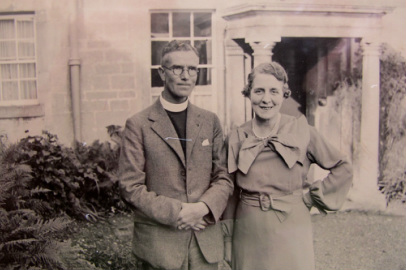 George & Kate Foster, photo courtesy Margaret Wakefield
George & Kate Foster, photo courtesy Margaret Wakefield
Twenty years later Rev George Foster and his wife Kate recalled some of these activities:
What happy memories Box conjures up for us. The services for 'Publicans and Sinners' at 9:45 on Sundays; services in the Northey Arms’ grounds with Bishops and the Corsham Town Band; Hazelbury pageant; ‘The Way of Compassion’; the Box Blackbirds with Roddy Hughes giving ‘excerpts from his extensive repertoire’, ‘Mrs Gorrinnge’s Necklace’, ‘Dolly Reforming Herself’, the concert parties, ‘Some Rubbish’, ‘More Rubbish’ and ‘Still More Rubbish’. Then there were the many Passion plays and Nativity plays which Kate wrote for the Box Players’ Guild.[15]
What happy memories Box conjures up for us. The services for 'Publicans and Sinners' at 9:45 on Sundays; services in the Northey Arms’ grounds with Bishops and the Corsham Town Band; Hazelbury pageant; ‘The Way of Compassion’; the Box Blackbirds with Roddy Hughes giving ‘excerpts from his extensive repertoire’, ‘Mrs Gorrinnge’s Necklace’, ‘Dolly Reforming Herself’, the concert parties, ‘Some Rubbish’, ‘More Rubbish’ and ‘Still More Rubbish’. Then there were the many Passion plays and Nativity plays which Kate wrote for the Box Players’ Guild.[15]
In 1925, the parish council considered the provision of a public recreation ground, but was unable to finance the proposal. A year later, George Kidston came to the rescue, purchasing and donating two fields formerly belonging to Manor Farm, subject to an agreement with the Cricket Club.[16] Sir Edmund Northey, owner of Manor Farm, sold the land to Mr Kidston at a greatly reduced price, for the purpose of providing a public recreation ground (Box Rec).
It was an important gesture and the field has many times united the whole village in celebrations as well as providing a safe and convenient playing area for local children who otherwise had to play on the unconcreted school playground that was described in 1927 as either a sea of mud or a veritable Sahara of germ-pervaded dust.[17]
It was an important gesture and the field has many times united the whole village in celebrations as well as providing a safe and convenient playing area for local children who otherwise had to play on the unconcreted school playground that was described in 1927 as either a sea of mud or a veritable Sahara of germ-pervaded dust.[17]
Threshold of a Modern Society
Nowadays we tend to view the problems of the 1920s as a transition period to a modern society.
Nowadays we tend to view the problems of the 1920s as a transition period to a modern society.
|
When the motorcar first arrived in Box, it marked the start of a totally new era.
By 1922, the old agricultural yard at Manor Farm had ceased to be used for horse and carriage purposes and had been turned into High Street Garage. In the 1920’s the roads were being surfaced with tarmac and traffic on the A4 increased greatly: In 1922 a 16-hour census of motor traffic passing along the Chippenham Road was taken. The average was 3½ vehicles per minute. The volume increased greatly and by 1928 there were 10 vehicles per minute.[18] |
The Bath Electric Tramway was criticised for the reckless manner the motor buses drive down Box Hill and through the village.[19] It got worse in 1930 when the speed limit was increased to 22 miles per hour.[20] It was claimed that Jim and George Browning and their Boxonian motor coach firmly established motor transport in the village.
The cost of a car was out of the reach of most residents who resorted to rail travel. Box Halt at Mill Lane was opened on 31 March 1930 to cater for them. Its purpose was to encourage passenger rail traffic to seek employment in other local towns. It is claimed that villagers listened for the train whistle at Box Station before rushing out of doors to catch the train at Box Halt.
The cost of a car was out of the reach of most residents who resorted to rail travel. Box Halt at Mill Lane was opened on 31 March 1930 to cater for them. Its purpose was to encourage passenger rail traffic to seek employment in other local towns. It is claimed that villagers listened for the train whistle at Box Station before rushing out of doors to catch the train at Box Halt.
Of particular concern after the war was the state of the housing stock, particularly smaller, tenanted agricultural properties. In Box, complaints of domestic overcrowding were sent to the parish council in 1927 and a request was made to build twenty or thirty council houses in the village at a rent of 5s per week. In 1929, bungalows were built in The Bassets, the name possibly being derived from quarry terminology, where the edge of a stone outcrop reached the surface.[21] By 1931 the rural district council was formally asked to build up the stock of council houses.
Conclusion
It is hard to find positive social outcomes from the war. The overwhelming conclusion we have today is the same as contemporaries: this must never happen again. The conflict scarred our collective consciousness and left a permanent memorial in every village and town, the War Memorials, recording the lists of the local dead. The elders of the village hoped that their loss would be the last similar such tragedy but it was not to be. In Box in 2014, we have also remembered them and pledged our hope that this will never recur again.
And we leave the last word on World War One to Box resident, Col JDB Erskine DSO, founder and secretary of the Comrades Legion Club and member of the British Legion Relief Fund Committee, who died in May 1926: [22]
I saw these wonderful men live, and I saw many die, and formed the resolve that if I returned to England I would do all I could to help those who came through the war.
Conclusion
It is hard to find positive social outcomes from the war. The overwhelming conclusion we have today is the same as contemporaries: this must never happen again. The conflict scarred our collective consciousness and left a permanent memorial in every village and town, the War Memorials, recording the lists of the local dead. The elders of the village hoped that their loss would be the last similar such tragedy but it was not to be. In Box in 2014, we have also remembered them and pledged our hope that this will never recur again.
And we leave the last word on World War One to Box resident, Col JDB Erskine DSO, founder and secretary of the Comrades Legion Club and member of the British Legion Relief Fund Committee, who died in May 1926: [22]
I saw these wonderful men live, and I saw many die, and formed the resolve that if I returned to England I would do all I could to help those who came through the war.
References
[1] Donald Bradfield, A Century of Village Cricket, 1964
[2] David Ibberson, Lambert’s Way: Scouting in Box 1910 to 1985, p.7 & 12
[3] Parish Magazine, March & August 1924
[4] Liz Price, Bath Freestone Workings, p.48
[5] Victoria County History, Vol IV, p.230
[6] NJ McCamley, Secret Underground Cities, 2001, Leo Cooper, p.17
[7] Christopher Hibbert, The English: A Social History, 1987, Paladin, p.696
[8] Michael Marshman, Wiltshire Life Magazine, April 2005
[9] Ken Tatem, A History of the By Brook, The Environment Agency
[10] Parish Magazine, January 1926
[11] Parish Magazine, June 1930
[12] Parish Magazine, Jan 1926
[13] Christopher Hibbert, The English: A Social History, 1987, p.696
[14] RJ Tucker, Scripta Legenda, Vol I, 1986, Free Troglophile Association Press, p.35-7
[15] Parish Magazine, August 1932
[16] Clare Higgens, Box Wiltshire: An Intimate History, 1985, Downland Press, p.52
[17] Parish Magazine, February 1927
[18] Parish Magazine, November 1933
[19] Clare Higgens, Box Wiltshire: An Intimate History, p.50
[20] Christopher Hibbert, The English: A Social History, p.677
[21] Dictionary definition
[22] Parish Magazine, May 1926
Thanks
Thanks to Jane Browning for suggesting many of the details included in this article.
[1] Donald Bradfield, A Century of Village Cricket, 1964
[2] David Ibberson, Lambert’s Way: Scouting in Box 1910 to 1985, p.7 & 12
[3] Parish Magazine, March & August 1924
[4] Liz Price, Bath Freestone Workings, p.48
[5] Victoria County History, Vol IV, p.230
[6] NJ McCamley, Secret Underground Cities, 2001, Leo Cooper, p.17
[7] Christopher Hibbert, The English: A Social History, 1987, Paladin, p.696
[8] Michael Marshman, Wiltshire Life Magazine, April 2005
[9] Ken Tatem, A History of the By Brook, The Environment Agency
[10] Parish Magazine, January 1926
[11] Parish Magazine, June 1930
[12] Parish Magazine, Jan 1926
[13] Christopher Hibbert, The English: A Social History, 1987, p.696
[14] RJ Tucker, Scripta Legenda, Vol I, 1986, Free Troglophile Association Press, p.35-7
[15] Parish Magazine, August 1932
[16] Clare Higgens, Box Wiltshire: An Intimate History, 1985, Downland Press, p.52
[17] Parish Magazine, February 1927
[18] Parish Magazine, November 1933
[19] Clare Higgens, Box Wiltshire: An Intimate History, p.50
[20] Christopher Hibbert, The English: A Social History, p.677
[21] Dictionary definition
[22] Parish Magazine, May 1926
Thanks
Thanks to Jane Browning for suggesting many of the details included in this article.
